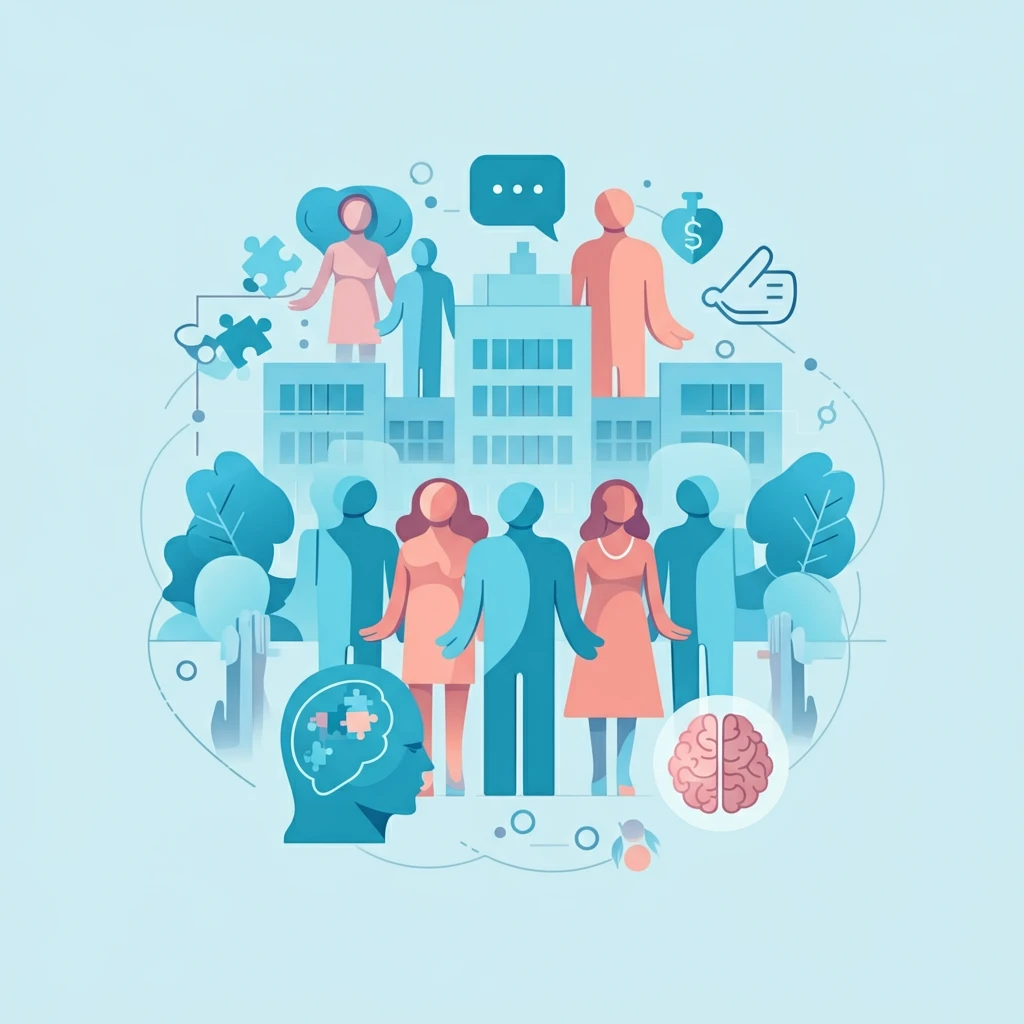Introduction
Autism Spectrum Disorder (ASD) is a complex developmental condition that affects how individuals perceive and interact with the world. It can impact communication, behavior, and social interactions, often presenting unique challenges for both individuals and their families. Understanding and navigating life with autism can feel overwhelming, but there is hope, especially when the diagnosis is timely and accurate.
This article aims to answer the important question, “How is autism diagnosed?” We will walk you through the autism diagnosis process, shedding light on what to expect and the steps involved in assessing and identifying ASD. Early diagnosis plays a vital role in ensuring access to appropriate support, services, and interventions that empower individuals with autism to thrive. Together, we’ll explore the key aspects of autism spectrum disorder diagnosis and provide insights to guide you on this important journey.
Understanding Autism Spectrum Disorder (ASD)
Autism Spectrum Disorder (ASD) is a neurodevelopmental condition characterized by challenges in social communication and interaction, as well as the presence of restricted, repetitive patterns of behavior. These core characteristics can manifest in unique ways for each individual, reflecting the diverse range of experiences within the autism spectrum. For some, difficulties may arise in understanding social cues or forming interpersonal connections, while others may engage in repetitive movements, demonstrate a strong adherence to routines, or exhibit intense focus on specific interests.
ASD is further categorized into three severity levels, highlighting the varying degrees of support individuals may require. Level 1, often referred to as “requiring support,” includes those who may have mild challenges in social situations or adapting to changes. Level 2, “requiring substantial support,” indicates individuals who face more pronounced difficulties in communication and daily activities. Lastly, Level 3, “requiring very substantial support,” applies to individuals with significant challenges that can impact their ability to function independently.
Clinical observation remains a key component in evaluating autism spectrum disorder, alongside developmental history and specialized assessment tools. Understanding the complexity of ASD and its varying presentations empowers families, caregivers, and professionals to provide compassionate and tailored support, ensuring that individuals with autism can reach their fullest potential.
Signs and Early Red Flags of Autism in Children
Recognizing the signs of autism early can make a significant difference in identifying the right support and interventions for a child. Some common behavioral signs that may indicate a child is at risk for autism include challenges with joint attention, such as difficulty making eye contact or following another person’s gaze. Delayed speech milestones are another frequent concern, where a child may struggle to use words or gestures to communicate effectively by the expected age.
It is important to understand the differences between autism-related behaviors and typical developmental variations, such as a speech delay. For example, while some children with speech delays may still engage in rich nonverbal communication and social interaction, children on the autism spectrum may exhibit reduced interest in social connection altogether. A developmental pediatrician is invaluable in assessing these patterns, providing insights through detailed evaluation tools, and distinguishing autism characteristics from other developmental delays. Early identification of these red flags allows families to take meaningful steps toward fostering growth, learning, and emotional well-being.
The Autism Diagnosis Process: From Screening to Formal Evaluation
The process of diagnosing autism begins with routine developmental screenings, often conducted by pediatricians during well-child visits. These screenings are critical in identifying early concerns and ensuring that children receive the support they need as soon as possible. A commonly used tool is the Modified Checklist for Autism in Toddlers (M-CHAT), a questionnaire designed to flag potential signs of autism in young children. When concerns are identified during screenings, families are typically referred for more comprehensive evaluations.
Formal diagnoses often involve multidisciplinary teams, which may include developmental pediatricians, child psychologists, speech therapists, and other specialists. These experts use a combination of assessments and observations to gain a deeper understanding of the child’s behavior, communication, and developmental progress. A widely recognized tool in this process is the Autism Diagnostic Observation Schedule (ADOS), which provides a structured framework for observing social interaction, communication, and play. By combining insights from these tools with the expertise of skilled professionals, families receive accurate diagnoses, empowering them to access tailored resources and interventions.
Understanding the Clinical Criteria for Autism Diagnosis
Autism diagnosis relies on a comprehensive assessment guided by the criteria outlined in the DSM-5 (Diagnostic and Statistical Manual of Mental Disorders, Fifth Edition). The DSM-5 autism criteria focus on two main areas: persistent deficits in social communication and interaction, and restricted, repetitive patterns of behavior, interests, or activities.
For social communication, individuals with autism may face challenges such as difficulty maintaining conversations, interpreting nonverbal cues, or understanding social norms. For example, a child might struggle to make eye contact or have trouble perceiving the emotions of others. On the other hand, restricted interests and behaviors can manifest as intense focus on specific topics, repetitive movements like hand-flapping, or adherence to strict routines.
By using this structured framework, clinicians can evaluate a range of behaviors and developmental patterns, ensuring an accurate and compassionate diagnosis that informs effective support and interventions for each individual’s unique needs.
Age Considerations in Autism Diagnosis: Early Identification Matters
Early autism diagnosis plays a critical role in providing timely support and interventions that can profoundly improve outcomes for children and their families. Autism symptoms are often identifiable as early as 18 months to 2 years of age, with many developmental milestones providing insight into potential neurodivergent behaviors. During this typical age range, signs such as delayed speech, difficulties with social engagement, or repetitive behaviors may emerge, prompting further assessment.
The benefits of early intervention cannot be overstated. Identifying autism during early childhood allows families, educators, and healthcare providers to implement tailored therapies, helping children build essential social, communication, and adaptive skills at a young age when their brains are most malleable. These supports not only foster immediate development but also set the foundation for long-term growth and independence.
However, diagnosing autism in older children, teenagers, or adults presents distinct challenges. Over time, many individuals develop compensatory strategies to mask or adapt to their autistic traits, making their differences less apparent to those around them. This can lead to delays in diagnosis or even misdiagnoses, potentially depriving them of necessary understanding and support. A compassionate, patient approach is required to recognize these subtler traits and to validate the lived experiences of those whose diagnoses may come later in life.
Autism Diagnosis in India: A Focus on Mumbai
Autism diagnosis in India is becoming increasingly recognized as an essential step toward providing meaningful support to individuals and families navigating the autism spectrum. However, accessibility and availability of diagnostic services remain significant challenges, particularly outside major metropolitan areas. Mumbai stands out as a critical hub for autism diagnosis, offering a range of specialized services and expertise vital for identifying autism at various life stages. Parents and caregivers in Mumbai often seek help at autism rehabilitation centers, which provide not only diagnostic tools but also a supportive environment for post-diagnosis care.
One key concern for families is knowing how autism is diagnosed and understanding the steps involved. The process typically includes developmental screenings, evaluations by multidisciplinary teams like developmental pediatricians, psychologists, and speech therapists, and in-depth discussions regarding parental observations. Early parental concern plays a pivotal role in initiating the diagnostic process, which highlights the value of awareness campaigns and educational resources for caregivers.
Local rehabilitation centers in Mumbai are instrumental in bridging the gap between diagnosis and ongoing care. These centers offer holistic support, combining therapy programs, skill-building exercises, and parental guidance to help individuals on the spectrum thrive. By fostering community connections and offering inclusive services, these institutions are ensuring that individuals with autism and their families feel understood and empowered in their unique journeys.
Post-Diagnosis Support and Intervention Options for Individuals with Autism
Receiving an autism diagnosis can feel overwhelming, but it also opens the door to accessing vital support and resources that can make a profound difference in a child’s development. Therapy is often a foundational component of post-diagnosis care, offering tailored approaches to address the unique needs of individuals on the spectrum.
Speech therapy is one of the most recommended interventions, as it helps improve communication skills, ranging from basic verbal abilities to nonverbal communication techniques like using gestures or visual aids. For many children, this therapy can foster meaningful connections with those around them. Occupational therapy is another critical avenue of support, focusing on improving sensory processing skills, motor coordination, and the ability to perform daily tasks effectively. These therapies work hand-in-hand to build independence and confidence.
Early intervention programs, particularly in cities like Mumbai, play a pivotal role in influencing developmental outcomes. The best autism therapy centers in Mumbai not only offer comprehensive solutions but also provide guidance for families, ensuring they feel equipped to support their loved ones. Through these early efforts, children are given the tools they need to build a strong foundation for the future and achieve their fullest potential.
Conclusion
If you have concerns about your child’s development or behavior, it’s important to remember that early action can make a significant difference. Reaching out to professionals who specialize in autism can provide clarity and guidance on the next steps. To address questions like, “How is autism diagnosed?” or to better understand your child’s unique needs, it is highly recommended to seek an autism assessment from trusted experts.
Parents and caregivers in the Mumbai region have access to a range of resources. You can contact autism specialists in Mumbai who are committed to offering personalized approaches and insights. Additionally, if you’re ready to take the next step, it’s easy to book an autism assessment in Mumbai, ensuring your child receives the care and support they truly deserve. Remember, you are not alone in this journey—there is help and hope available at every step.









Leave a Reply